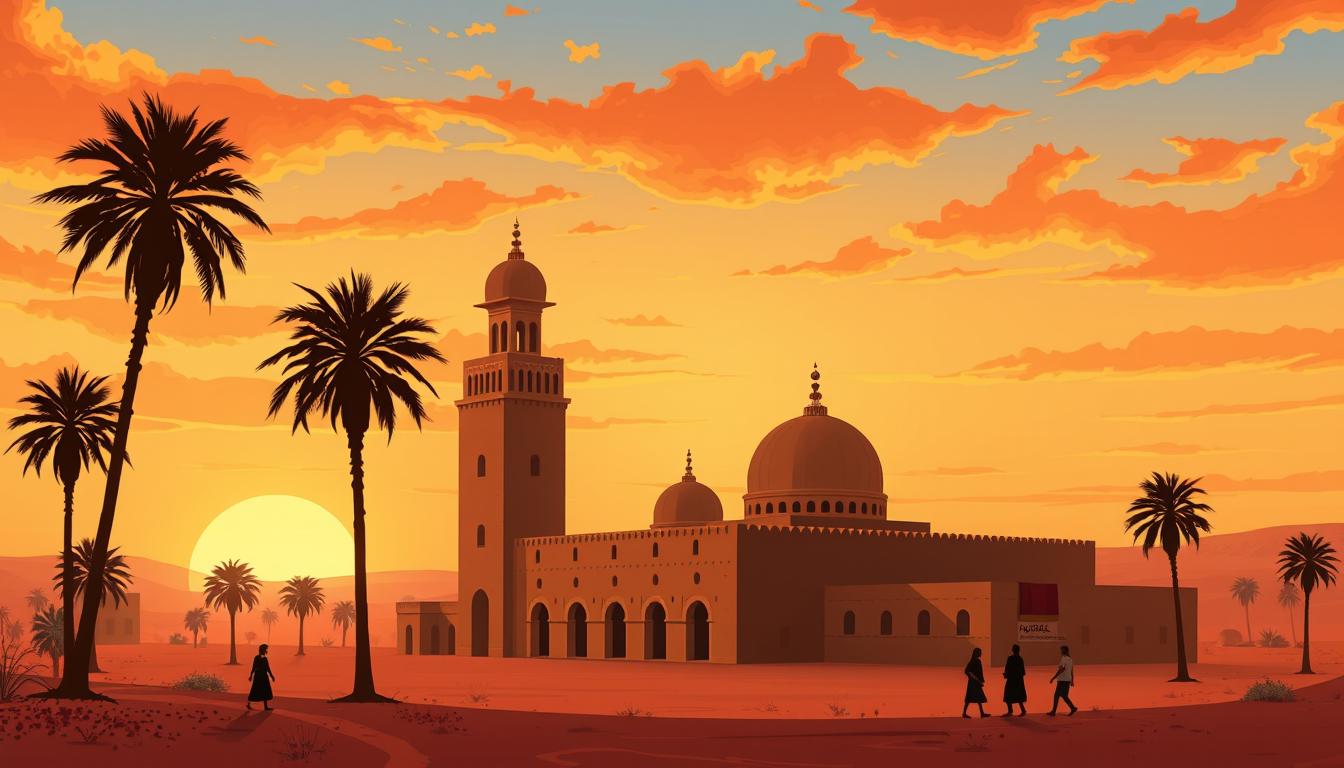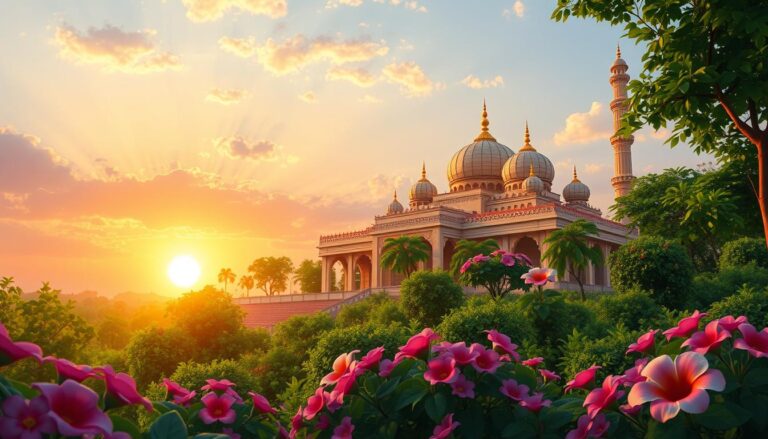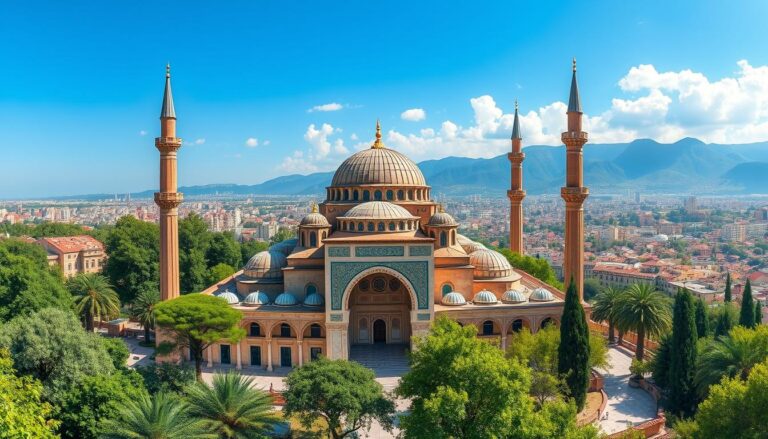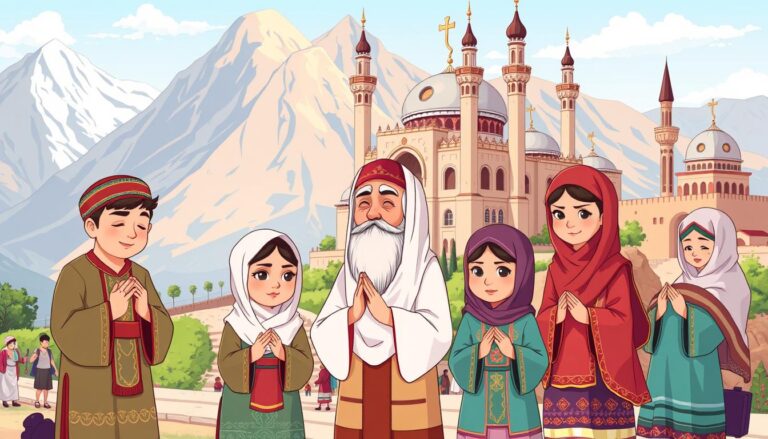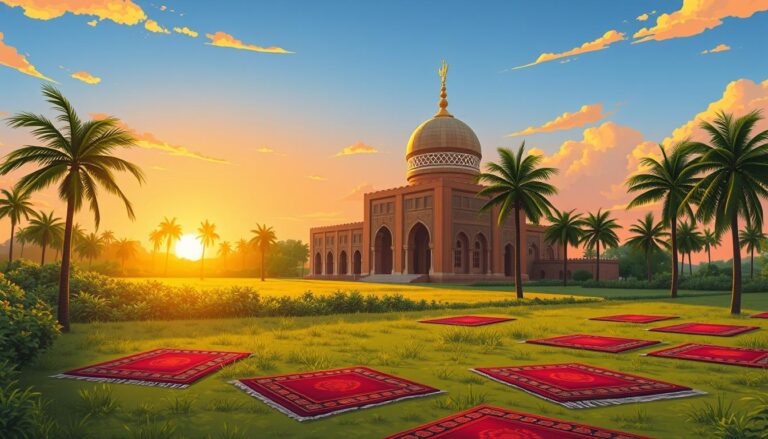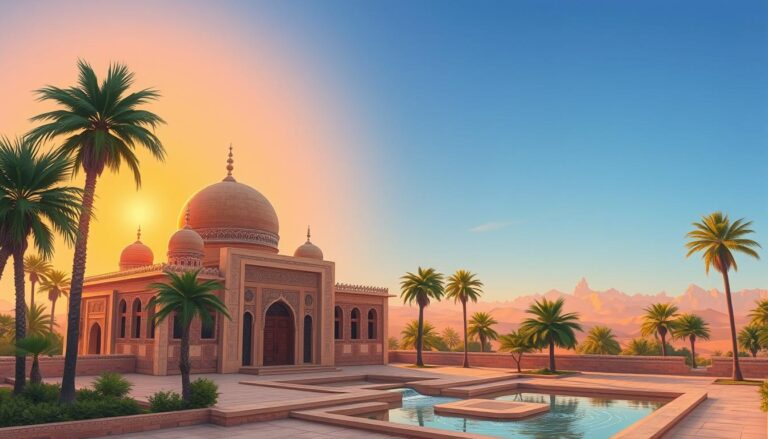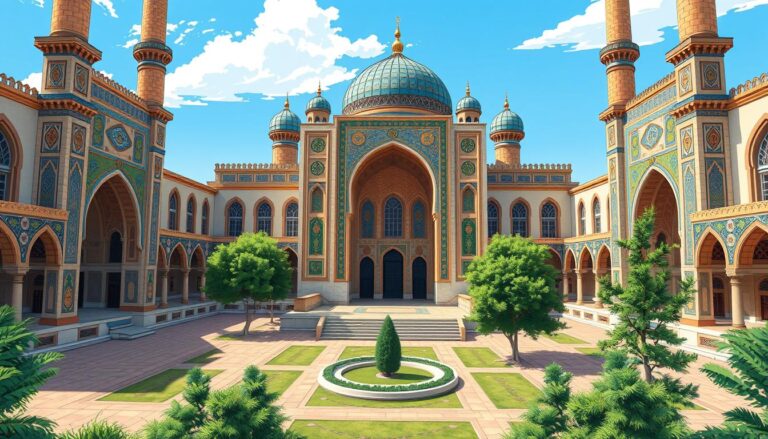Islam in Mali
Mali, a West African nation, has a deep connection to Islam. About 95 percent of the people here are Muslim. This article will explore the history, culture, architecture, and challenges of Islam in Mali.
The journey of Islam in Mali is both ancient and modern. It spans from the Islamic empires of West Africa to today’s Mali. We’ll look at mosques, Islamic learning centers, and traditions that have lasted for centuries.
Introduction to Islam in Mali
Islam is the main religion in Mali, with most people being Sunni Muslims. The country’s religious scene shows the strong impact of Islamic traditions. These traditions are deeply woven into Malian society.
Mali’s Religious Landscape
In Mali, Sunni Islam, especially the Maliki school, is the most common. But, there are also Ahmadiyya and Shia Muslims. Sufi mystical practices add to the country’s rich Islamic heritage. They have greatly influenced Malians’ cultural and spiritual lives.
The Significance of Islam in Malian Society
Islam plays a huge role in Malian society. It has deeply influenced the country’s culture, social life, and politics. From grand mosques to daily prayers, Islam’s impact is everywhere. Mali’s religious demographics and the importance of Islam in Malian culture show how deeply the faith is rooted in the country.
“Islam has been woven into the fabric of Malian society, shaping its cultural, social, and political aspects.”
The Malian people’s love for Islam is clear in their rich Islamic heritage. Islamic institutions are prominent, and religion is a big part of their daily lives. This shows how important Islam is in Malian society.
Islamic Empires of West Africa
Mali has been at the heart of many powerful Islamic empires. The Ghana Empire thrived from the 9th to the 13th centuries, blending Islam into its politics and economy. Islam spread quickly across northern Africa after the death of Prophet Muhammad.
The Mali Empire followed the Ghana Empire and reached its peak under Mansa Musa. He was a devout Muslim who grew the empire and encouraged Islamic studies. His famous trip to Mecca in 1324 made Mali a hub of Islamic culture and learning.
- The Mali Empire reached its largest size in the 14th century, covering a huge area from Senegambia to Ivory Coast.
- Mali was famous for its wealthy rulers and their riches, which were known worldwide.
- Leaders like Mansa Musa were celebrated for their wealth and leadership, as noted by Ibn Khaldun and Ibn Battuta.
The Songhai Empire later took over Mali and also played a big role in spreading Islam. The influence of Islam helped protect Africans from slavery and shaped African Islam with its own traditions.
“Mali’s emperors were known for their riches and the vast resources in their empire, making it renowned far beyond Africa, spreading across the Old World.”
Islam in Mali: A Blend of Tradition and Faith
Islam in Mali is a mix of tradition and faith. It combines local African religions and Sufi influences. The Muslim population has chosen parts of Islam to blend with their traditions and beliefs.
Sufism, a mystical part of Islam, has shaped Mali’s religious scene. It has helped the country be open and accepting of different Islamic views.
Sufi Influences and Mystical Practices
Sufi orders have deeply influenced Malian Islam. They focus on mysticism and spiritual devotion. This has mixed Sufism in Mali with traditional African religion, creating a unique blending of Islamic and local practices.
Malian Muslims use Sufi elements like honoring saints and chanting in their worship. This makes their Islam a mix of their culture and faith.
“Islam in Mali has evolved into a unique blend of tradition and faith, incorporating elements of local African religions and Sufi influences.”
The Dogon people of Mali mix traditional African beliefs with Sufi Islam. This mix has helped the country be diverse and tolerant. Muslims, Christians, and followers of traditional African religions live together peacefully.
Sufi orders are seen in Mali’s architecture, music, and culture. Sufi lodges, or zawiyas, are places of learning and spiritual guidance. They attract people from all walks of life, enriching Malian religious life.
Architecture and Islamic Heritage
Mali’s rich Islamic history shines through its amazing buildings. These structures show the country’s deep cultural and religious roots. The Great Mosque of Djenné stands out as a masterpiece of Malian Islamic architecture.
The Great Mosque of Djenné
Built in the 13th century, the Great Mosque of Djenné is a marvel. It’s the largest mud brick building in the world. Its unique design and towering minaret make it a symbol of Malian Islamic heritage.
Timbuktu: A Center of Islamic Learning
Timbuktu is another key site in Mali’s Islamic history. It was a major center of learning during the Songhai Empire. By the 16th century, Timbuktu had 150 to 180 Qur’anic schools.
The Mali Empire made Timbuktu a center of commerce and learning. They built important mosques like the Djinguereber Mosque and the Sankoré Mosque. Timbuktu’s Koranic Sankore University is one of the oldest universities in Sub-Saharan Africa.
This university has a vast collection of ancient manuscripts. These manuscripts show the intellectual wealth of the Mali Empire. Malian scholar Dr. Abdel Kader Haidara and his team are working to protect this cultural treasure.
“Timbuktu’s legacy as a center of Islamic learning is further reinforced by the presence of the Koranic Sankore University, one of the oldest higher-education facilities in Sub-Saharan Africa.”
Islam in Mali
Islam is the main religion in Mali, with about 95% of people calling themselves Muslim. Most Malian Muslims follow the Sunni Maliki school of thought. They also have influences from Sufism. Besides, there are Ahmadiyya and Shia minorities, and people who follow traditional African religions.
Mali’s history with Islam goes back to the powerful empires of the Western Sahara. The city of Timbuktu was a key center for over 600 years. It was famous for its university, unmatched in sub-Saharan Africa for its learning.
Today, Mali is seen as an independent, democratic, and culturally rich country. Islam’s impact is clear in Mali’s buildings, art, literature, and traditions. Timbuktu’s ancient manuscripts show the area’s deep Islamic roots.
“Timbuktu has a tradition of book production stretching back almost 1,000 years, and its manuscripts have unique bindings and decorations different from other Islamic manuscripts.”
The Islamic demographics in Mali are as follows:
- Muslims make up about 95% of the population.
- Shia Muslims are around 10% of Muslims in Mali, says a Shia imam.
- Christian groups, mostly Catholic and Protestant, make up less than 5% of the population.
- The Church of Jesus Christ of Latter-day Saints has about 100 members in Mali.
- Many people in Mali, especially in rural areas, follow traditional African religions.
- In Bamako, less than 1,000 people are part of Dawa al-Tablig, a Sunni subgroup, as the MARCC estimates.
The rich Islamic heritage and demographics in Mali deeply influence the country’s culture, society, and politics. This makes Islam a key part of Mali’s identity.
Conversion and Spread of Islam
The spread of Islam in West Africa, like in the Mali Empire, was linked to trade. North African and Saharan merchant-scholars were key in spreading the faith. They were trusted advisors and scribes in non-Muslim kingdoms.
Their work helped local rulers and people adopt Islamic practices and knowledge.
The Role of Trade and Merchant-Scholars
Islam started spreading through trade in the 8th century CE, reaching Lake Chad in West Africa. The 13th to 17th centuries saw Islam grow fast, thanks to the Mali Empire. Mansa Musa, Mali’s famous ruler, brought scholars from Mecca and built the Great Mosque of Timbuktu.
Merchant-scholars were vital in spreading Islam in West Africa. They traded goods and shared Islamic teachings with local communities. Their efforts helped Islamic traditions become part of West African societies, leading to Islamization over time.
“By the second half of the tenth century, the Sahara had become Dar al-Islam, the ‘Abode of Islam.'”
The role of trade in Islamizing West Africa is huge. Muslims from North Africa and the Sahara promoted their faith through trade. This helped in the gradual conversion of West African populations to Islam. Muslim merchant-scholars were key in bridging Islamic and local traditions.
Malian Islamic Scholars and Leaders
Mali is known for its deep Islamic roots. It has given birth to many important Islamic scholars and leaders. Mansa Musa, who ruled in the 14th century, is one of the most famous. He was a devout Muslim and made a famous trip to Mecca.
Mansa Musa: The Legendary Pilgrimage
Mansa Musa’s trip to Mecca was known for its grandeur. He showed off Mali’s wealth and supported Islamic schools. His caravan was huge, with thousands of people and camels carrying gold and other treasures.
This display of wealth and faith made Mali famous. It showed the world Mali’s importance in Islamic scholarship and leadership.
“Mansa Musa’s pilgrimage to Mecca was a momentous event that elevated the global recognition of Malian Islamic scholars and the country’s religious significance.”
The legacy of Mansa Musa and others like him still shapes Mali today. Their work has greatly influenced Islam in West Africa. Their impact is still seen in the region’s rich Islamic heritage.
Islam and Malian Society Today
Islam is a big part of Malian life, with about 95% of people practicing it every day. Most Muslims in Mali follow the Malikite Sunni branch, with some Sufism and smaller Ahmadiyya and Shia groups. The country’s history shows a blend of mystical elements, ancestor veneration, and African Traditional Religion with Islam.
Mali has always been known for its tolerance towards Islam. But lately, there’s been a rise in stricter Islamic views, especially in the north. This has led to harsh punishments like cutting off hands or feet for thieves and stoning adulterers, under Sharia law.
Religious Practices and Tolerance
Despite these issues, many Muslim leaders in Mali don’t want strict Sharia law. The government also makes sure all religions are treated equally. The High Council of Islam, set up in 2002, helps manage religious affairs for Muslims nationwide.
The situation with Islam in Mali is complex and varied. Different leaders and groups have different ideas about how religion should fit into society. For example, Mahmoud Dicko, the head of the High Islamic Council, is seen as conservative. On the other hand, Ousmane Madani Haïdara, leader of Ansar Dine, is known for opposing extremism and promoting being good Muslims and citizens.
“Islam continues to be a central aspect of Malian society today, with the majority of the population practicing their faith daily. While the country has traditionally been known for its relatively tolerant and moderate approach to Islam, there has been a surge in more conservative interpretations of the religion, particularly in the northern regions.”
Challenges and Extremism
Mali was once known for its rich Islamic heritage and religious tolerance. But, extremist groups like Ansar Dine have risen in the north. They threaten the heart of Malian society.
The Northern Mali Conflict and Its Impact
The conflict in Northern Mali has deeply affected the country. Extremist groups aim to impose strict Sharia law. They target religious minorities, destroy Islamic sites, and persecute others.
This has challenged Mali’s long-standing tradition of tolerance and moderation. The Sahel region, including Mali, has faced severe security and humanitarian crises since gaining independence in the 1960s. Weak governance, economic decline, and climate change have fueled violent extremism.
- Groups like JNIM and ISGS have increased violence in the Sahel.
- ISWAP, a Boko Haram splinter, pledged allegiance to the Islamic State in 2015.
- Chad, Mali, and Nigeria are among the most fragile states, according to the Fragile State Index.
The effects of extremism in Mali are widespread, threatening social and religious unity. The Northern Mali conflict has made the situation dire. The impact of extremism on Malian society is felt nationwide.
“The decline in security in Africa’s Sahel region over the past decade has facilitated violent extremist organizations affiliated with al-Qaida and the Islamic State to exploit weak governments and failed states across the region.”
Islamic Art and Culture in Mali
Islam has a big impact on Mali’s art and culture. The country’s Malian Islamic music, Malian Islamic literature, and Malian Islamic craftsmanship show a mix of Islamic and African traditions.
Music, Literature, and Craftsmanship
Malian Islamic scholars and artists have created unique music, poetry, and textiles. These works are deeply rooted in the country’s Islamic heritage. The Islamic art in Mali shows how spiritual and artistic can come together beautifully.
“Malian Islamic music, with its captivating rhythms and soulful melodies, has become an integral part of the country’s cultural identity.”
Malian Islamic literature is also very important. It helps keep Islamic knowledge and traditions alive. Scholars have written many texts and poems that inspire and educate people all over the world.
The Malian Islamic craftsmanship is another example of the country’s talent. Artisans create detailed textiles, pottery, and metalwork. They use Islamic motifs and techniques, showing off the region’s unique cultural heritage.
These artistic expressions have made Mali’s culture richer. They have also helped people around the world appreciate Mali’s diverse and vibrant heritage.
Conclusion
Mali’s story with Islam is a mix of tradition, faith, and the rise and fall of Islamic empires. The country’s Islamic heritage shows in its buildings and art. It proves Islam’s lasting importance in Malian life.
Mali must keep its moderate and tolerant view of Islam. It also needs to tackle extremism. This way, Mali can keep its religious communities in harmony and grow together.
The summary of Islam in Mali shows a deep faith connection and a rich cultural legacy. Mali must face extremism and religious intolerance head-on. With a focus on interfaith dialogue and tolerance, Islam can unite Mali’s people and help the country thrive.
Source Links
- Islam in Mali
- The Spread of Islam in West Africa: Containment, Mixing, and Reform from
- Islam in Mali since the 2012 coup
- Trade and the Spread of Islam in Africa | Essay | The Metropolitan Museum of Art | Heilbrunn Timeline of Art History
- Microsoft Word – Final.docx
- Religion in Mali
- Religion
- How Timbuktu Flourished During the Golden Age of Islam | HISTORY
- Timbuktu
- Timbuktu: An Islamic Cultural Center | Articles and Essays | Islamic Manuscripts from Mali | Digital Collections | Library of Congress
- Mali – United States Department of State
- The Spread of Islam in Ancient Africa
- Islam in West Africa. Introduction, spread and effects – History Textbook
- Islam and Politics in Mali What Stakes
- Sacred struggles: How Islam shapes politics in Mali
- Mali’s referendum on a new constitution many Muslims oppose
- Violent Extremism in the Sahel | Global Conflict Tracker
- DOD Seeks to Quell Violent Extremism in Africa’s Sahel Region
- Diakaridia Traoré: Exploring Mali’s Religious Cultures – African Studies Center
- ISLAMIC ARCHITECTURE in MALI, West Africa (Djenne, Timbuktu)
- Mali – United States Department of State

